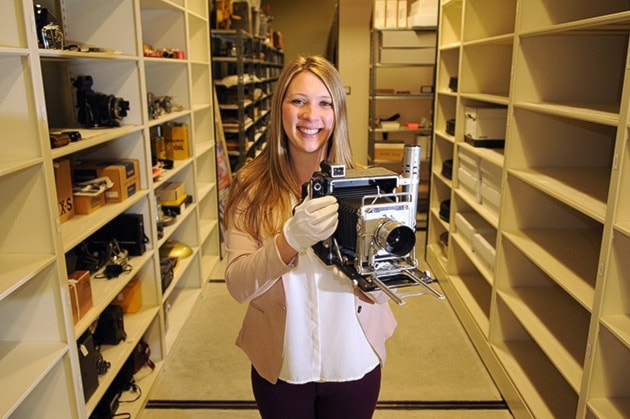A new photo exhibition at the museum will expose the viewer to the history of photography, changes in its technology and how it has shaped today’s world, as well as some of the earliest images taken in Chilliwack.
Photography from Obscura to App opens next week at the Chilliwack Museum and runs for 10 months.
“We have a fantastic collection, so it seemed like a natural fit for us. We have close to a million photos, and a lot of cameras,” says Jane Lemke, curator at the Chilliwack Museum and Archives.
One of their biggest photography collections comes from Norman Williams of Norman’s Photographic. They have 400,000 images from Norman’s Photographic alone, plus many of Williams’ cameras.
One very special camera that will be on display is Williams’ Graflex Speed Graphic. Purchased in 1947, and used for more than two decades into the 1970s, he lugged the heavy 4x5 film camera to all of his photo shoots.
“Norman photographed almost everyone in Chilliwack, from weddings, to family portraits, to school portraits, to the fair,” says Lemke.
In addition to his famous Speed Graphic camera, Williams has donated hundreds of cameras from his own personal collection to the archives.
“He was a camera collector. He really knew what he was looking for in a camera, so the cameras he had were quite unique,” says Lemke.
Some of the pieces from Williams’ camera collection will also be on display, like different generations of Kodak’s classic Brownie camera.
But before Williams captured the faces of Chilliwack on film, there was another photographer who did the same — though it was 50 years earlier and the images were made on glass plate negatives.
James Orville Booen was an itinerant photographer who was in Chilliwack from 1895 to 1896.
“He was only here for a very short time but his are some of the oldest photos we have of Chilliwack,” says Lemke.
Booen was known for photographing people who, back in the day, would not typically have been photographed — people who couldn’t afford to be photographed like First Nations, Japanese, and the poor.
“They’re substantial photos. It’s a fantastic collection,” says Lemke.
There are 300 glass plate negatives made by Booen at the archives. They’ve been digitized, and about 100 of his images will be shown on a continuous loop on a monitor during the exhibition. (See one of Booen's photos below)
Also on display will be a very interesting collection of F.G. Leary, who owned The Palms Confectionary and Ice Cream Parlour, where he also sold postcards.
Last year, a collection of 130 glass plate 4x5 negatives were found in a dumpster in Ladner, B.C. They were identified as being taken in Chilliwack, and were then donated to the Chilliwack Museum and Archives.
In the collection were scenic glass plate negatives of Chilliwack. The staff at the archives recognized them, as they had many of the positive images in postcard form already in their collections.
In addition, there was a negative of Leary himself standing in front of his store with his postcards behind him. The postcards in that photo are the same images on the glass plate negatives found in the dumpster that were given to the archives.
Other highlights in the exhibition include a projector from the Paramount cinema, a film reel of Mr. Bean, flash sheets (which would be lit on fire and used as a flash), cameras made from Bakelite, a video of Chilliwack secondary students developing film, a first generation iPhone (on loan from the owner who was still using it), and one of The Progress’s digital cameras which died after it was dropped into a slough.
The exhibition starts with camera obscura, a pre-photography technique used as an aid for drawing and painting. The name ‘camera obscura’ was coined in the 1600s, and it is a darkened box or room with an aperture which projects the image of an external object onto a screen or wall inside.
From camera obscura, the photo exhibition moves onto daguerreotype (photographs made on sheets of silver-plated copper), tintype (making a positive image on a thin sheet of metal), wet plate and dry plate (using glass plates), film, moving film, instant film, and finally digital.
Local photographers Norman Williams and Don Young will be at the opening reception on Sept. 22. Young will have cameras on hand, explaining different types of photo techniques to people.
Photography from Obscura to App runs Sept. 23 to June 11, 2017 at the Chilliwack Museum (45820 Spadina Ave.). Opening reception is Thursday, Sept. 22 from 7 to 9 p.m. Admission is free on opening day. Regular admission rates are $3 for adults and $2 for students and seniors. Hours are Mondays to Fridays from 9 a.m. to 4:30 p.m. (Thursdays open until 8:30 p.m.), and Saturdays from 10 a.m. to 2 p.m.
jenna.hauck@theprogress.comtwitter.com/PhotoJennalism

